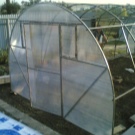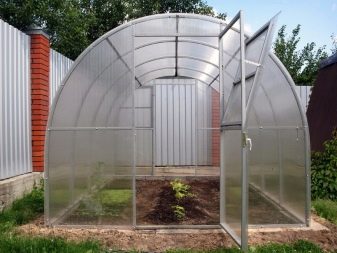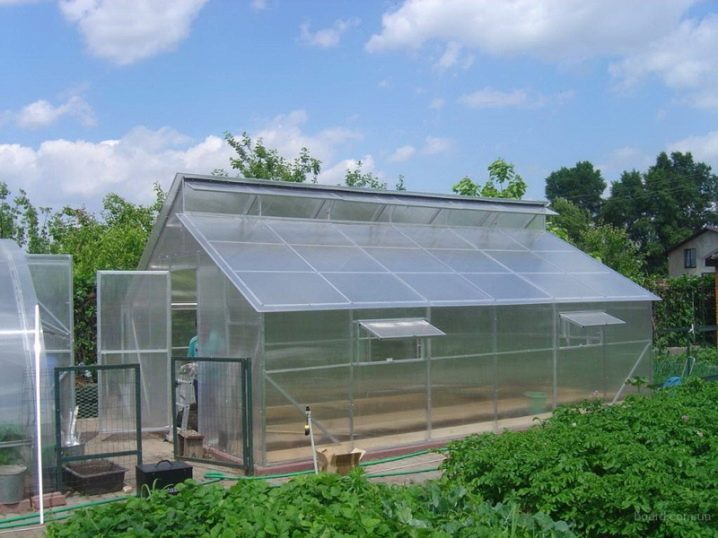Polycarbonate greenhouses: types and benefits

Modern greenhouses significantly increase the vegetation cycle of various plants. That is why such facilities are so widespread throughout Russia. They can be found on the backyards from Smolensk to Khabarovsk. The secret of such popularity is obvious: greenhouses reliably protect plants from the harmful effects of the environment, are easy to install, and are inexpensive. Polycarbonate has become the main material that is present today almost everywhere and there are also good reasons for this.
Special features
Greenhouses and greenhouses are close "relatives", but have their own characteristics in size and range of crops grown.The size of greenhouses vary in width and length. Their height also does not have any standards. All sizes depend on the crop grown in them and the capabilities of the owner of the site. There are a lot of proposals for ready greenhouses in the trade network, and for greenhouses in a wide range there is only cover material, sometimes mounted at the same time with plastic arcs. Polycarbonate framework for greenhouses - the latest trend of progress in this business.
A greenhouse is a simple and reliable object that is able to realize reliable protection of the crop as it is of small frosts in early spring, and heavy rainfall on summer days. But they are seasonal structures, without additional heating, so they are used only from spring to autumn, after which they are disassembled and stored for storage until the next spring.
Before building and, moreover, using a polycarbonate object, everything should be carefully prepared, the parameters should be calculated, and the plan-scheme should be correctly drawn. It is especially important to understand how many square meters will be required for beds. If there is a defect or error, then in the future this will affect the crop yield, it may be necessary to incur additional costs to eliminate the deficiencies.
What is different from the greenhouse?
The greenhouse and greenhouse are very similar, but there are differences between them. Greenhouses appeared in the XVI century in France, they were created in the form of greenhouses. After two hundred years glass greenhouses replaced the greenhouses. Then the PVC film Greenhouses came onto the scene - these are “mini-greenhouses”, structures that are notable for their small height, about 1.4 meters. In the greenhouses there is no heating, heating occurs due to sunlight and the decomposition of manure and humus. There are no doors in the greenhouses, access to plants is possible if you open the roof or side.
In greenhouses it is convenient to grow seedlings, they can be both stationary and mobile. In early spring, when snow is still melting in the fields, and frost occurs at night, greenhouses are an indispensable tool in the economy. Inside the greenhouse the air warms up to the desired condition, the seedlings feel comfortable. The height of greenhouses starts at 1.8 meters and can reach more than five meters. Often mini-tractors and other equipment are easily placed in such structures. Heating in greenhouses is possible with additional heating. There is equipment that maintains the specified parameters of humidity in the room and the temperature of the soil.
Greenhouses solve specific problems, their purpose depends on the crops that are grown in them.
At the beginning of the 21st century, nothing better can be found than polycarbonate for building greenhouses. It meets the necessary requirements, and is not inferior in strength to glass. The era when glass and PVC film were the only materials to cover greenhouses, forever sunk into oblivion.
The disadvantages of traditional materials:
- glass has considerable weight and high cost;
- glass is fragile and hard to work with;
- glass installation is not an easy task;
- PVC film is a cheap, but extremely short-lived material.
Cellular polycarbonate in terms of transparency and strength is not inferior to glass. It has special protective coatings from excessive UV radiation. The weight of polycarbonate is 3.5 times less than glass; it is simpler to mount such material, it reliably maintains any temperature fluctuations of the external environment and humidity.
Polycarbonate has an unusual structure. The outer layer is a solid sheet, in which there is a protective UV coating that protects from excessive exposure to sunlight.The middle layer consists of micro-cells resembling honeycombs. Such an arrangement creates an ideal thermal insulation, and also significantly strengthens the sheet structure, which prolongs the service life. The bottom layer provides additional rigidity and protective features.
A greenhouse made of polycarbonate weighs a little, it does not require a massive concrete foundation. This fact can significantly reduce the costs of the construction of the object, as the strip foundation is not cheap. Polycarbonate is very durable, has good thermal insulation properties. In this case, the coating can withstand the thickness of the snow layer with a thickness of several tens of centimeters. Another positive feature of polycarbonate is fire safety. Ignition is possible only at temperatures close to 610 degrees Celsius. It contains special additives, it burns badly and for the most part melts.
Advantages and disadvantages
If you make a shed polycarbonate roof, then its advantage will be that it is done simply and quickly. Of the minuses can be called the fact that the usable area is small, the lighting leaves much to be desired.If there is a dual-roof greenhouse roof, the lighting is much better. Bearing elements are more durable, but building such an object is more expensive, and much more effort and materials are required here. Often, gardeners put old frames on the roofs that do not look quite comme il faut; moreover, they should be regularly cleaned of snow in winter.
Often you can find greenhouse hangar type polycarbonate, such objects have undeniable advantages:
- low cost;
- ease of assembly;
- plants are fully illuminated with light;
- excellent weather and moisture protection;
- sheets easily attached to the frame;
- You can operate the facility all year round;
- fire safety;
- the ability to use the facility 12 months a year.
Among the shortcomings we can recall the need to carefully seal the ends and joints. Possible also deformation of the roof in the formation of significant layers of melting snow.
Kinds
Garden greenhouse arch type like a tunnel. The object is going to simply follow the standard scheme. Self-made portable greenhouses are always popular, for growing seedlings is difficult to come up with something better.There are greenhouses, immersed percent of 15 in the ground, which makes it possible to maintain the required temperature in the cold. There are also “Bochka” and “Breadbox” hotbeds - they can be both stationary and portable.
Frame materials
In addition to polycarbonate actively The following materials are used:
- metal corners (aluminum, steel);
- wooden bars (2x4 cm);
- PVC pipes are often used, so the frame becomes more rigid and reinforced.
The product weighs a little, often 12x12 cm timber is put in the base, which is necessarily treated with a primer - antiseptic, and then dried well.
Constructions and forms
In total there are several options for greenhouses with opening top. "Shell" is an object that has a cross section of the type of arched structure with a semicircular top. The farmer can, by opening the doors, work with cultures directly through the sliding roof without additional stairs and other devices.
The “tavern” also has a truncated arch at its base, the sides of which open up on both sides. The greenhouse at this moment looks like butterfly wings. The second name of such greenhouses - "Butterfly"."Belgian" is a greenhouse "house" with a rectangular case that looks like a box. The hinged roof is most often odnoskatnoy, it really resembles the cover of the chest.
The greenhouse convertible is built on a standard principle. The main difficulty is to correctly connect the nodes of the lid itself using special fasteners. The lid to the frame of the timber is attached with reliable hinges, on the principle of the door. It is also recommended to provide strong clamps that would hold the lid in position. The "Belgian" model is suitable for any areas, it can be both stationary and portable. Planning allows for a short time to reach out to any plant.
Dimensions
The size of the greenhouse is relatively small. At a plot of six acres, you can often find objects no more than 3x4 meters. Often also found buildings 3 by 6 meters, a width of 2 m, and 2x4 meters. The roof in such constructions is polycarbonate, which is almost two hundred times stronger than the glass, and the transparency coefficient is approximately the same. Polycarbonate is plastic, easy to bend, easy to install,polycarbonate greenhouse can be collected in half an hour.
Particularly noteworthy are small mini-greenhouses, in which the main material is polycarbonate. For growing seedlings like small buildings are perfect. Also in the mini greenhouse grow greens and radishes, they are narrow and low; it is convenient to work with them, no ladders or extras are needed. A mini greenhouse can even be placed on a windowsill or on a loggia, it can be used all year round.
How to choose?
When choosing a polycarbonate should be considered important features. For example, a protective layer that is present in this material. It is better to buy polycarbonate known manufacturer, thereby you can protect yourself from fakes. It is very important to pay attention to the label on which there is all the output given material. Plates in which there is a special layer for protection against UV radiation are denoted by the term: "Top".
Installing a greenhouse depends on the level of groundwater. If the plot is marshy and located in a lowland, then it is necessary to create a “pillow” - a flat hillock of gravel on which it will be possible to build an object.As a rule, greenhouses are made of rectangular or square shape. The “starting point” is a standard polycarbonate sheet. The height is usually no more than 1.5 meters.
Width usually has the following components:
- the width of the beds is 1 meter;
- track width about 0.5 meters;
- wall thickness.
There are special greenhouses:
- for cucumbers;
- for peppers;
- for seedlings.
To give such objects (their rating is high) are often irreplaceable, especially if the area is not very large. Ready reviews, if desired, can always be read on the Internet.
How to build?
Making a greenhouse with your own hands is not a daunting task. Work starts with the analysis of materials for the greenhouse. Then make a sketch of a drawing of a structure that you want to do on your own site. After a schematic refinement of the main idea, taken from own considerations, it is possible to make a detailed drawing of the future object.
For miniature greenhouse polycarbonate there is no need to make a massive foundation of concrete slabs or bricks. For these purposes, timber or planks may well be suitable. It is very important to comply with all technological standards. The tree should be processed with a special primer.Work begins with the correct markup on the site. This will require a good two-meter level, rods of reinforcement and thread.
When designing a greenhouse should provide space for vents, as well as racks for plants. In the greenhouse there must be a permanent air exchange, so the vents are necessarily needed. For a greenhouse it is best to establish a foundation on stilts.
The benefits of this foundation:
- piles can be quickly and correctly put;
- in terms of strength and durability, the piles will not yield to the strip foundation;
- no need to wait for a long time when the foundation shrinks;
- the cost of the pile foundation is four times less than the belt one.
Polycarbonate sheets have a standard length of 6 meters and a width of 2.05 meters. When creating a diagram or drawing, it is these standards that should be considered. And the sheet can be easily cut in half.
Greenhouses can be single-slope and dual-slope. If the building is located near the main house or garage, then it will be shed. The level of snow load in winter depends on the angle of inclination of the roof. The greater the angle of inclination of the roof, the less snow will accumulate on it during snowfall, which means that the risk that the roof will be deformed will decrease. Usually the angle of inclination varies from 20 to 50 degrees.For bearing structures most often used are metal angles. Aluminum is more preferable, it does not corrode and is relatively inexpensive. The distance between the bearing structures does not exceed one meter.
Carrying mounts are also made from shaped pipes, in this case logs can be used as a foundation. To make an object with your own hands, the easiest way is to use wooden structures, it is easy to process it, if you use the necessary primer, the wood will not be damaged or affected by microorganisms. Also important is the fact that the tree looks aesthetically and organically, it "fits" in any landscape design.
On the foundation to erect a wooden frame is also not particularly difficult, it should be done in stages. If the foundation is on piles, then it is important to correctly install the grillage from a beam or channel, and a structure is attached to it.
The fastener of the frame to the foundation has three degrees:
- total cutting;
- cutting down a small area;
- fastening structures using corners.
The last way is the easiest, even a schoolboy can cope with this task.
As a piece of advice, it can be noted that during work, temporary diagonal supports can be placed that will take on the vibration load. This will ensure that the roof is not deformed. Aluminum profiles - the simplest for the manufacture of construction, they are not subject to corrosion. They also make the assembly of the greenhouse frame of PVC pipes.
The advantage of this scheme:
- low weight;
- you can quickly assemble;
- small price;
- pipes are not subject to corrosion.
Pipes can be bolted and angles, PVC materials can be welded. The walls of the greenhouse must be strengthened with additional ribs. This is necessary to increase the strength factor. Usually diagonally mounted bars are 8 millimeters thick. This is quite enough for the roof to withstand the snow load or the pressure of a strong wind.
The joints of polycarbonate sheets and corners provide special rubber washers. They do not allow moisture or condensate to leak into the room. Also, rubber effectively protects plastic from mechanical damage and chips, and you can make these consumables yourself.During the work it is necessary to consider that it is comfortable to work with polycarbonate at a temperature from +10 degrees. If the temperature is close to zero, the material is “compressed” and becomes excessively hard. It is easier to install a flat roof, but this will lead to premature wear of the structure and damage to the roof. After the construction of the structure, the joints remain, through which moisture can enter, they must be “blown out” with assembly foam or filled with sealant.
How to wash?
Country polycarbonate greenhouse requires appropriate care. Once every six months, the roof should be wiped with a damp cloth moistened with soapy water. Before starting wintering, each wall of the greenhouse must be wiped from the inside with a sponge dipped in soapy water. Special attention should be paid to the joints and seams. In these places most often pests lay eggs, which in the spring can turn into larvae. It is not recommended to add chlorine to the soap solution; it can damage plants as it is a potent poison.
The surface of the polycarbonate is very fragile, any mechanical effect leaves a mark on the material. Acids and potent alkalis should also not be used, the surface of polycarbonate will become cloudy from them. After sanitization, all the flaps should be opened so that they can dry well.
In the second half of March, all shelves and stands are removed from the greenhouse. It should check and wipe the roof. Be sure to open all the transom so that the room is dry (must be a fine, windy day). All joints and related accessories should be checked to ensure that there is no mold on them. Just in case, you will need to wipe all wooden structures with an antiseptic primer.
Metal parts are painted with antivirus and then enameled. Polycarbonate is wiped with a sponge soaked in soapy water. If there are chips or scratches, then they are recommended to be sealed with special glue. After winter, sometimes the sheets are deformed, they need to be checked. Comprehensive work must always be carried out - this is a guarantee of a future good harvest.
How to build a polycarbonate greenhouse, see the following video.























































































